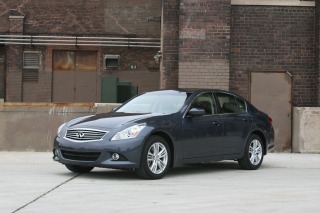
A year into its rebirth, the Buick Regal adds two versions for 2012. The mild-hybrid Regal eAssist. It’s rare when an automaker launches a less-powerful version of one of its cars, but that’s what happened when Infiniti introduced the G25 entry-luxury sedan.
The 2012 G25 is a less-expensive alternative to Infiniti’s mainstay G37, yet it offers much of the sporty, athletic driving experience we’ve come to love in that car. And that lower price is welcome because the G25 isn’t significantly more fuel efficient than the G37.
The base rear-wheel-drive G25 starts at $32,600, which is $3,800 less than the rear-drive G37 sedan. (To see all the differences between the two, click here.) We tested an all-wheel-drive G25x, which lists for $35,600. A few options raised the as-tested price to $37,675. To see the G25 and G37 compared side-by-side with the Cadillac CTS and BMW 3 Series, click here.
Styling
The G’s exterior design has aged well since this generation’s launch as a 2007 model. Its smooth lines are quite a departure from the Cadillac CTS’ creased styling and the Mercedes C-Class’ angular shape. The design works from any angle, which isn’t the case with every car design.
The G25 is the base model in the G lineup, but its styling doesn’t shout that fact; luxury-car shoppers looking to save some dough will surely appreciate that. It has standard 17-inch aluminum-alloy rims that do a good job filling out the wheel wells. Apart from the badge on the trunk lid, it’s indistinguishable from the more potent G37.
Snowstorm-Approved
We don’t always have the opportunity to see how an all-wheel-drive car performs in snow, but the keys to the G25x arrived along with a storm that dumped 6 inches of snow on Chicago in the course of an afternoon. Though traffic made the drive home twice as long, the G25x handled the messy roads without drama, plodding along through a thick soup of fallen snow. This was with all-season tires, too, rather than dedicated winter tires.
The G25x includes a Snow mode, which significantly decreases gas-pedal sensitivity in an effort to limit wheelspin. Unfortunately, it’s excessively intrusive. In short order I turned it off, instead relying on gradual accelerator use and all-wheel drive to keep the car moving.
When starting out from a stop, the sedan’s tail would step to the side ever so slightly before the all-wheel drive detected wheel slip and engaged the front wheels to help the car move. Dubbed ATTESA E-TS for Advanced Total Traction Engineering System for All Electronic Torque Split, this on-demand system is different from Audi’s or Subaru’s all-wheel-drive systems, which constantly send power to all four wheels.
Dry-Pavement Performance
I was pleasantly surprised by the G25x’s performance, as it delivers more than adequate acceleration while retaining the balanced dynamics that have made the G one of the few luxury cars to credibly challenge the BMW 3 Series’ handling prowess.
Decent performance from a small-displacement V-6 isn’t a foregone conclusion, as the Lexus IS demonstrates: With a 204-horsepower, 2.5-liter V-6, the base Lexus IS 250 is a completely different car from the IS 350, which has a potent 306-hp, 3.5-liter V-6. The horsepower gulf between the 218-hp G25 and the 328-hp G37 appears similarly wide on paper, but the difference feels much smaller on the road.
The G25x moves out well, even with the extra weight of all-wheel drive. Where it loses a step to its more powerful sibling is on the highway; it doesn’t accelerate with the same authority when you want to make a quick move around traffic.
Both versions of the G use a seven-speed automatic transmission, though the G37 can be optioned with a six-speed manual. The automatic’s shifts are unobtrusive, and the multitude of forward gears doesn’t make the transmission feel overly busy. There’s not much kickdown delay when you stand on the gas pedal.
The G25x’s gas savings aren’t as great as you might expect. The automatic-equipped G37 gets an EPA-estimated 19/27 mpg city/highway, while the G25, which is offered only with an automatic transmission, is rated 20/29 mpg. The difference in combined city/highway fuel economy between the two is 1 mpg: 22 mpg for the G37 and 23 for the G25, an improvement of about 5 percent. The difference for the all-wheel-drive models is similarly minimal: The G37x is rated 18/25 mpg and the G25x is 19/27 mpg.
The Audi A4 and BMW 328i are more efficient. The two-wheel-drive A4 is rated 22/30 mpg, and the 328i is 24/36 mpg. Both these cars are powered by turbocharged four-cylinders, whereas the G25 has a V-6.
What hasn’t been lost are the impressive dynamic qualities that the G37 — and before it the G35 — has had for years. It’s why the G should be on your must-drive list if you’re shopping for a luxury sedan that’s engaging to drive. There’s that connection to the road when you’re in the driver’s seat that’s difficult for automakers to create, but which is instantly recognizable. A combination of minimal body roll, a rear-wheel-drive platform, and nicely weighted, responsive steering deserve much of the credit. Even with all-wheel drive, the G25x retains the feel of a rear-drive sedan.
The G25x doesn’t isolate you from the road, but rather communicates its details. You feel bumps, but responses are damped well enough to prevent the ride from feeling harsh.
Cabin Quality
The G25x’s trim fit is good, but there are some instances of less-than-stellar materials quality. The plastic on the door armrests, for example, looks out of place in a luxury sedan. This cabin design is now one of the older ones in this class, and it’s showing a bit.
The front bucket seats are finished in standard leather upholstery and have power adjustments. They’re comfortable, and I like how the instrument panel moves with the steering wheel when you tilt it, which helps prevent the gauges from being blocked by the steering wheel. Taller drivers might want a little more seat travel; I’m 6-foot-1, and I had the seat all the way back.
Backseat passengers enjoy stadium-style seating, with good forward views. However, there’s not much space for your feet under the front seats, and my head was brushing against the ceiling. The driveshaft hump in the middle of the floor takes up a lot of foot space, too.
Safety
The G received Good scores in the Insurance Institute for Highway Safety’s frontal-offset and side-impact crash tests, an Acceptable rating in its roof-strength test, and a Marginal score for neck protection in rear impacts.
Standard safety features include antilock brakes and an electronic stability system, which are required on all new vehicles as of the 2012 model year. Also standard are side-impact airbags for the front seats, side curtain airbags and active head restraints for the front seats.
For a full list of safety features, check out the Features & Specs page.
G25x in the Market
With car shoppers increasingly on the hunt for value, the G25’s timing couldn’t be better. By knocking thousands of dollars off the G’s starting price, Infiniti widens the car’s appeal without sacrificing the things that have made the car great. I was expecting greater gas savings, but the G25x is well-executed overall. Infiniti shouldn’t have trouble finding takers.





















